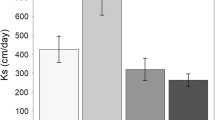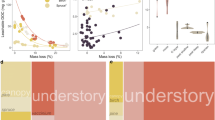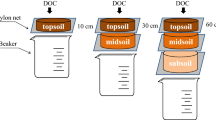Abstract
Although dissolved organic matter (DOM) released from the forest floor plays a crucial role in transporting carbon and major nutrients through the soil profile, its formation and responses to changing litter inputs are only partially understood. To gain insights into the controlling mechanisms of DOM release from the forest floor, we investigated responses of the concentrations and fluxes of dissolved organic carbon (DOC) and nitrogen (DON) in forest floor leachates to manipulations of throughfall (TF) flow and aboveground litter inputs (litter removal, litter addition, and glucose addition) at a hardwood stand in Bavaria, Germany. Over the two-year study period, litter manipulations resulted in significant changes in C and N stocks of the uppermost organic horizon (Oi). DOC and DON losses via forest floor leaching represented 8 and 11% of annual litterfall C and N inputs at the control, respectively. The exclusion of aboveground litter inputs caused a slight decrease in DOC release from the Oi horizon but no change in the overall leaching losses of DOC and DON in forest floor leachates. In contrast, the addition of litter or glucose increased the release of DOC and DON either from the Oi or from the lower horizons (Oe + Oa). Net releases of DOC from the Oe + Oa horizons over the entire manipulation period were not related to changes in microbial activity (measured as rates of basal and substrate-induced respiration) but to the original forest floor depths prior to manipulation, pointing to the flux control by the size of source pools rather than a straightforward relationship between microbial activity and DOM production. In response to doubled TF fluxes, net increases in DOM fluxes occurred in the lower forest floor, indicating the presence of substantial pools of potentially soluble organic matter in the Oe + Oa horizons. In contrast to the general assumption of DOM as a leaching product from recent litter, our results suggest that DOM in forest floor leachates is derived from both newly added litter and older organic horizons through complex interactions between microbial production and consumption and hydrologic transport.
Similar content being viewed by others
References
Anderson J.P.E. and Domsch K.H. 1978. A physiological method for the quantitative measurement of microbial biomass in soils. Soil Biol. Biochem. 10: 215–221.
Andersson S., Nilsson S.I. and Saetre P. 2000. Leaching of dissolved organic carbon (DOC) and dissolved organic nitrogen (DON) in mor humus as affected by temperature and pH. Soil Biol. Biochem. 32: 1–10.
Casals P., Romanya J., Cortina J., Fons J., Bode M. and Vallejo V.R. 1995. Nitrogen supply rate in Scots pine (Pinus sylvestris L.) forests of contrasting slope aspect. Plant Soil 168–169: 67–73.
Chahal K.S. and Wagner G.H. 1965. Decomposition of organic matter in Sanborn field soils amended with C14 glucose. Soil Sci. 100: 96–103.
Christ M.J. and David M.B. 1996a. Dynamics of extractable organic carbon in Spodosol forest floors. Soil Biol. Biochem. 28: 1171–1179.
Christ M.J. and David M.B. 1996b. Temperature and moisture effects on the production of dissolved organic carbon in a Spodosol. Soil Biol. Biochem. 28: 1191–1199.
Cortina J., Romanya J. and Vallejo V.R. 1995. Nitrogen and phosphorus leaching from the forest floor of a mature Pinus radiata stand. Geoderma 66: 321–330.
Cronan C.S. 1985. Comparative effects of precipitation acidity on three forest soils: carbon cycling responses. Plant Soil 88: 101–112.
Cronan C.S. and Aiken G.R. 1985. Chemistry and transport of soluble humic substances in forested watersheds of the Adirondack Park, New York. Geochim. Cosmochim. Ac. 49: 1697–1705.
Currie W.S. and Aber J.D. 1997. Modeling leaching as a decomposition process in humid montane forests. Ecology 78: 1844–1860.
Dai K., David M.B. and Vance G.F. 1996. Characterization of solid and dissolved carbon in a spruce-fir Spodosol. Biogeochemistry 35: 339–365.
Dawson H.J., Ugolini F.C., Hrutfiord B.F. and Zachara J. 1978. Role of soluble organics in the soil processes of a Podzol, Central Cascades Washington. Soil Sci. 126: 290–296.
DeLucia E.H., Hamilton J.G., Naidu S.L., Thomas R.B., Andrews J.A., Finzi A., Lavine M., Matamala R., Morhan J.E., Hendrey G.R. and Schlesinger W.H. 1999. Net primary production of a forest ecosystem with experimental CO2 enrichment. Science 284: 1177–1179.
Easthouse K.B., Mulder J., Christophersen N. and Seip H.M. 1992. Dissolved organic carbon fractions in soil and stream water during variable hydrological conditions at Birkenes, Southern Norway. Water Resour. Res. 28: 1585–1596.
Ellert B.H. and Gregorich E.G. 1995. Management-induced changes in the actively cycling fractions of soil organic matter. In: McFee W.M. and Kelly J.M. (eds) Carbon Forms and Functions in forest soils. Soil Sci. Soc. Am., Inc., Madison, pp 119–138.
Falkengren-Grerup U. and Tyler G. 1993. The importance of soil acidity moisture exchangeable cation pools and organic matter solubility to the cationic composition of beech forest (Fagus sylvatica L) soil solution. Z. Pflanz. Bodenkunde 156: 365–370.
Fisk M.C. and Fahey T.J. 2001. Microbial biomass and nitrogen cycling responses to fertilization and litter removal in young northern hardwood forests. Biogeochemistry 53: 201–223.
Gödde M., David M.B., Christ M.J., Kaupenjohann M. and Vance G.F. 1996. Carbon mobilization from the forest floor under red spruce in the northeastern USA. Soil Biol. Biochem. 28: 1181–1189.
Guggenberger G., Zech W. and Schulten H.-R. 1994. Formation and mobilization pathways of dissolved organic matter: evidence from chemical structural studies of organic matter fractions in acid forest floor solutions. Org. Geochem. 21: 51–66.
Hagedorn F., Blaser P. and Siegwolf R. 2002. Elevated atmospheric CO2 and increased N deposition effects on dissolved organic carbon – clues from ?13C signature. Soil Biol. Biochem. 34: 355–366.
Haider K. and Martin J.P. 1975. Decomposition of specifically carbon-14 labeled benzoic and cinnamic acid derivatives in soil. Soil Sci. Soc. Am. Proc. 39: 657–662.
Hongve D., Van Hees P.A.W. and Lundström U.S. 2000. Dissolved components in precipitation water percolated through forest litter. Eur. J. Soil Sci. 51: 667–677.
Joergensen R.G. 1996. The fumigation-extraction method to estimate soil microbial biomass: calibration of the kEC value. Soil Biol. Biochem. 28: 25–31.
Judd K.E. and Kling G.W. 2002. Production and export of dissolved C in arctic tundra mesocosms: the roles of vegetation and water flow. Biogeochemistry 60: 213–234.
Kaiser K., Guggenberger G. and Zech W. 1996. Sorption of DOM and DOM fractions to forest soils. Geoderma 74: 281–303.
Kaiser K., Guggenberger G., Haumaier L. and Zech W. 2001. Seasonal variations in the chemical composition of dissolved organic matter in organic forest floor layer leachates of old-growth Scots pine (Pinus sylvestris L.) and European beech (Fagus sylvatica L.) stands in northeastern Bavaria, Germany. Biogeochemistry 55: 103–143.
Kaiser K., Guggenberger G., Haumaier L. and Zech W. 2002. The composition of dissolved organic matter in forest soil solutions: changes induced by seasons and passage through the mineral soil. Org. Geochem. 33: 307–318.
Kalbitz K., Solinger S., Park J.H., Michalzik B. and Matzner E. 2000. Controls on the dynamics of dissolved organic matter in soils: a review. Soil Sci. 165: 277–304.
King J.S., Pregitzer K.S., Zak D.R., Sober J., Isebrands J.G., Dickson R.E., Hendrey G.R. and Karnosky D.F. 2001. Fine-root biomass and fluxes of soil carbon in young stands of paper birch and trembling aspen as affected by elevated atmospheric CO2 and tropospheric O3. Oecologia 128: 237–250.
Lichter J., Lavine M., Mace K.A., Richter D.D. and Schlesinger W.H. 2000. Throughfall chemistry in a loblolly pine plantation under elevated atmospheric CO2 concentrations. Biogeochemistry 50: 73–93.
Lin Q. and Brookes P.C. 1999. An evaluation of the substrate-induced respiration method. Soil Biol. Biochem. 31: 1969–1983.
Lischeid G. and Gerstberger P. 1997. The Steinkreuz Catchment as a BITÖK Main Investigation Site in the Steigerwald Region: Experimental Setup and First Results. Bayreuther Forum Ökologie Vol. 41.
Ludwig B., Heil B., Flessa H. and Beese F. 2000. Dissolved organic carbon in seepage water – production and transformation during soil passage. Acta Hydroch. Hydrob. 28: 77–82.
Lundquist E.J., Jackson L.E. and Scow K.M. 1999. Wet-dry cycles affect dissolved organic carbon in two Californian agricultural soils. Soil Biol. Biochem. 31: 1031–1038.
McDowell W.H. and Likens G.E. 1988. Origin, composition, and flux of dissolved organic carbon in the Hubbard Brook Valley. Ecol. Monogr. 58: 177–195.
McDowell W.H. and Wood T. 1984. Soil processes control dissolved organic carbon concentration in stream water. Soil Sci. 137: 23–32.
Merriam J., McDowell W.H. and Currie W.S. 1996. A high-temperature catalytic oxidation technique for determining total dissolved nitrogen. Soil Sci. Soc. Am. J. 60: 1050–1055.
Michalzik B. and Matzner E. 1999. Dynamics of dissolved organic nitrogen and carbon in a central European Norway spruce ecosystem. Eur. J. Soil Sci. 50: 1–12.
Michalzik B., Kalbitz K., Park J.H., Solinger S. and Matzner E. 2001. Fluxes and concentrations of dissolved organic carbon and nitrogen – a synthesis for temperate forests. Biogeochemistry 52: 173–205.
Neff J.C. and Asner G.P. 2001. Dissolved organic carbon in terrestrial ecosystems: synthesis and a model. Ecosystems 4: 29–48.
Palmer S.M., Hope D., Billett M.F., Dawson J.J.C. and Bryant C.L. 2001. Sources of organic and inorganic carbon in a headwater stream: evidence from carbon isotope studies. Biogeochemistry 52: 321–338.
Park J.H., Kalbitz K. and Matzner E. 2002. Resource control on the production of dissolved organic carbon and nitrogen in a deciduous forest floor. Soil Biol. Biochem. 34: 813–822.
Pohlman A.A. and McColl J.G. 1988. Soluble organics from forest litter and their role in metal dissolution. Soil Sci. Soc. Am. J. 52: 265–271.
Qualls R.G. 2000. Comparison of the behavior of soluble organic and inorganic nutrients in forest soils. Forest Ecol. Manag. 138: 29–50.
Qualls R.G. and Haines B.L. 1992. Biodegradability of dissolved organic matter in forest throughfall, soil solution, and stream water. Soil Sci. Soc. Am. J. 56: 578–586.
Qualls R.G., Haines B.L. and Swank W.T. 1991. Fluxes of dissolved organic nutrients and humic substances in a deciduous forest. Ecology 72: 254–266.
Richter D.D., Markewitz D., Trumbore S.E. and Wells C.G. 1999. Rapid accumulation and turnover of soil carbon in a re-establishing forest. Nature 400: 56–58.
Ross D.J. 1991. Microbial biomass in a stored soil: a comparison of different estimation procedures. Soil Biol. Biochem. 23: 1005–1007.
Rumpel C., Kögel-Knabner I. and Bruhn F. 2002. Vertical distribution, age, and chemical composition of organic carbon in two forest soils of different pedogenesis. Org. Geochem. 33: 1131–1142.
Schlesinger W.H. and Lichter J. 2001. Limited carbon storage in soil and litter of experimental forest plots under increased atmospheric CO2. Nature 411: 466–468.
Solinger S., Kalbitz K. and Matzner E. 2001. Controls on the dynamics of dissolved organic carbon and nitrogen in a Central European deciduous forest. Biogeochemistry 55: 327–349.
Sollins P. and McCorison F.M. 1981. Nitrogen and carbon solution chemistry of an old growth coniferous forest watershed before and after cutting. Water Resour. Res. 17: 1409–1418.
SPSS Inc. 1999. SPSS for Windows, Release 10. Chicago.
Sugai S.F. and Schimel J.P. 1993. Decomposition and biomass incorporation of 14C-labeled glucose and phenolics in taiga forest floor: effect of substrate quality, successional state, and season. Soil Biol. Biochem. 25: 1379–1389.
Tipping E. 1998. Modeling the properties and behavior of dissolved organic matter in soils. Mitt. der Deutschen Bodenkundlichen G. 87: 237–252.
Tipping E., Woof C., Rigg E., Harrison A.F., Inneson P., Taylor K., Benham D., Poskitt J., Rowland A.P., Bol R. and Harkness D.D. 1999. Climatic influences on the leaching of dissolved organic matter from upland UK moorland soils investigated by a field manipulation experiment. Environ. Int. 25: 83–95.
Trumbore S.E., Schiff S.L., Aravena R. and Elgood R. 1992. Sources and transformation of dissolved organic carbon in the Harp Lake forested catchment: the role of soils. Radiocarbon 34: 626–635.
Vance G.F. and David M.B. 1991. Forest soil response to acid and salt additions of sulfate: III. Solubilization and composition of dissolved organic carbon. Soil Sci. 151: 297–305.
Vance E.D., Brookes P.C. and Jenkinson D.S. 1987. An extraction method for measuring soil microbial biomass C. Soil Biol. Biochem. 19: 703–707.
Wardle D.A. and Ghani A. 1995. Why is the strength of relationships between pairs of methods for estimating soil microbial biomass often so variable? Soil Biol. Biochem. 27: 821–828.
Wardle D.A. and Parkinson D. 1990. Comparison of physiological techniques for estimating the response of the soil microbial biomass to soil moisture Soil Biol. Biochem. 22: 817–823.
Wagai R. and Sollins P. 2002. Biodegradation and regeneration of water-soluble carbon in a forest soil: leaching column study. Biol. Fert. Soils 35: 18–26.
Yavitt J.B. and Fahey T.J. 1986. Litter decay and leaching from the forest floor in Pinus contorta (lodgepole pine) ecosystems. J. Ecol. 74: 525–545.
Zech W., Guggenberger G., Haumaier L., Pöhhacker R., Schäfer D., Amelung W., Miltner A., Kaiser K. and Zieler F. 1996. Organic matter dynamics in forest soils of temperate and tropical ecosystems. In: Piccolo A. (ed), Humic Substances in Terrestrial Ecosystems. Elsevier Science, Amsterdam, pp. 101–170.
Zsolnay A. 1996. Dissolved humus in soil waters. In: Piccolo A. (ed). Humic Substances in Terrestrial Ecosystems. Elsevier Science, Amsterdam, pp. 101–170.
Rights and permissions
About this article
Cite this article
Park, JH., Matzner, E. Controls on the release of dissolved organic carbon and nitrogen from a deciduous forest floor investigated by manipulations of aboveground litter inputs and water flux. Biogeochemistry 66, 265–286 (2003). https://doi.org/10.1023/B:BIOG.0000005341.19412.7b
Issue Date:
DOI: https://doi.org/10.1023/B:BIOG.0000005341.19412.7b




